A Critical Review of Scarcity in the UK Healthcare Sector: Economics
VerifiedAdded on 2022/08/28
|16
|3691
|27
Report
AI Summary
This report critically reviews the economic issue of scarcity within the UK's healthcare sector. It highlights the imbalance between the endless needs of the population and the limited resources available, leading to significant challenges in service delivery and patient care. The report presents evidence of resource scarcity, including supply and demand dynamics, and employs an economic evaluation framework to assess the issue from multiple perspectives. The analysis reveals adverse impacts on the quality of care and potential long-term consequences, such as increased mortality rates. The report emphasizes the need for mitigation strategies, not only in the UK but also on a global scale, to address the challenges posed by scarcity in healthcare. The study also explores the causes of the scarcity, including population growth, demographic shifts, and the impact of climate change.
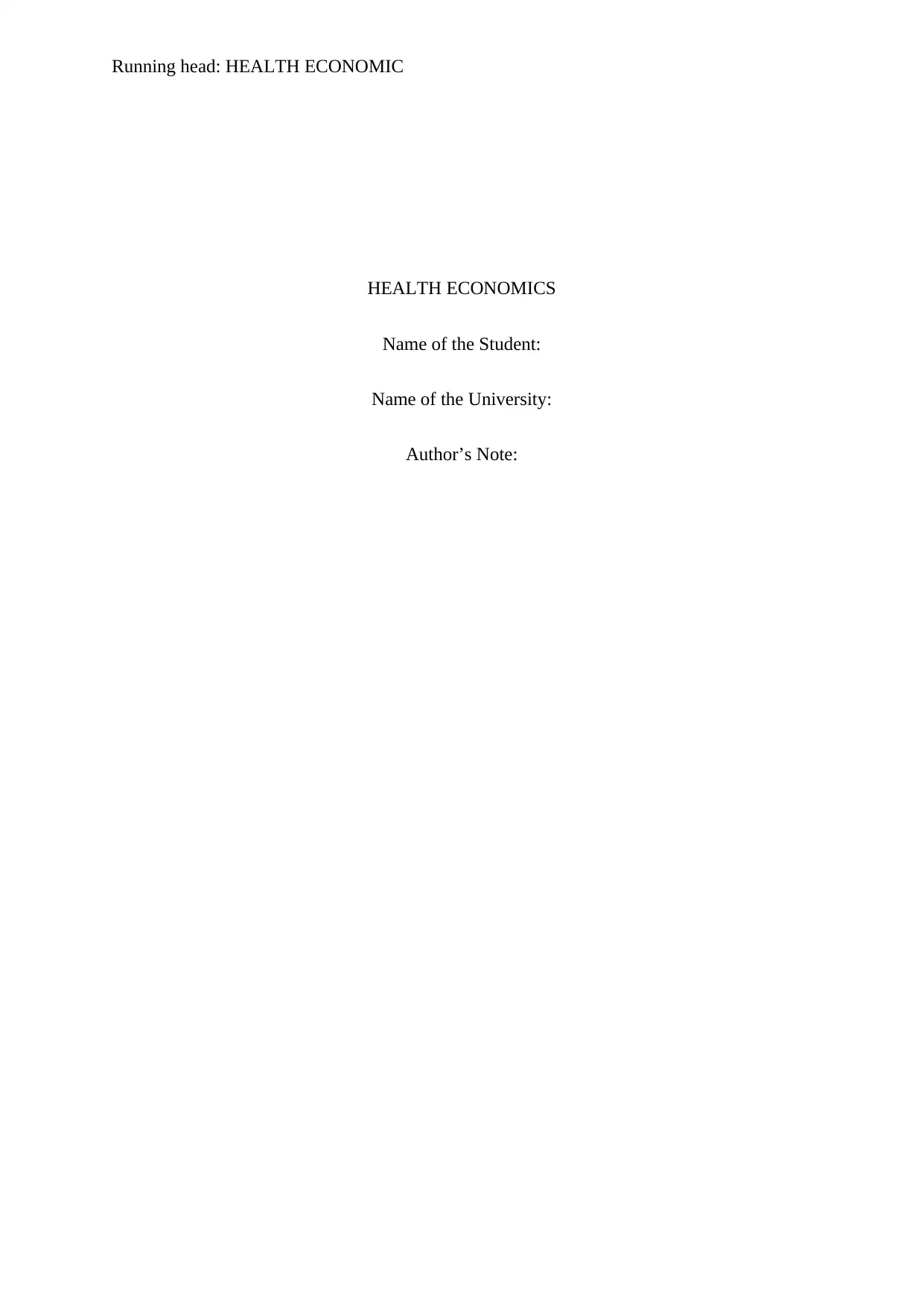
Running head: HEALTH ECONOMIC
HEALTH ECONOMICS
Name of the Student:
Name of the University:
Author’s Note:
HEALTH ECONOMICS
Name of the Student:
Name of the University:
Author’s Note:
Paraphrase This Document
Need a fresh take? Get an instant paraphrase of this document with our AI Paraphraser
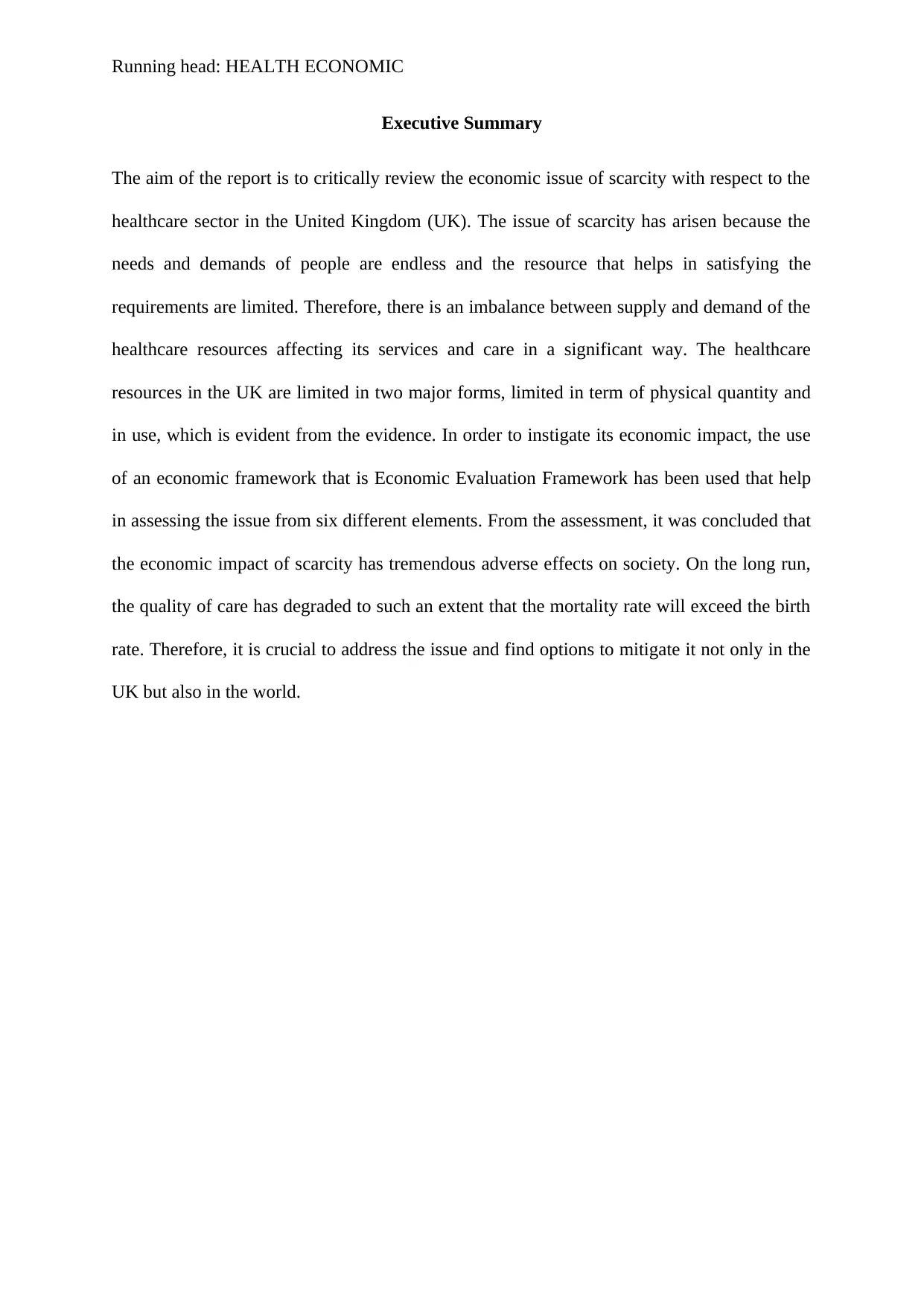
Running head: HEALTH ECONOMIC
Executive Summary
The aim of the report is to critically review the economic issue of scarcity with respect to the
healthcare sector in the United Kingdom (UK). The issue of scarcity has arisen because the
needs and demands of people are endless and the resource that helps in satisfying the
requirements are limited. Therefore, there is an imbalance between supply and demand of the
healthcare resources affecting its services and care in a significant way. The healthcare
resources in the UK are limited in two major forms, limited in term of physical quantity and
in use, which is evident from the evidence. In order to instigate its economic impact, the use
of an economic framework that is Economic Evaluation Framework has been used that help
in assessing the issue from six different elements. From the assessment, it was concluded that
the economic impact of scarcity has tremendous adverse effects on society. On the long run,
the quality of care has degraded to such an extent that the mortality rate will exceed the birth
rate. Therefore, it is crucial to address the issue and find options to mitigate it not only in the
UK but also in the world.
Executive Summary
The aim of the report is to critically review the economic issue of scarcity with respect to the
healthcare sector in the United Kingdom (UK). The issue of scarcity has arisen because the
needs and demands of people are endless and the resource that helps in satisfying the
requirements are limited. Therefore, there is an imbalance between supply and demand of the
healthcare resources affecting its services and care in a significant way. The healthcare
resources in the UK are limited in two major forms, limited in term of physical quantity and
in use, which is evident from the evidence. In order to instigate its economic impact, the use
of an economic framework that is Economic Evaluation Framework has been used that help
in assessing the issue from six different elements. From the assessment, it was concluded that
the economic impact of scarcity has tremendous adverse effects on society. On the long run,
the quality of care has degraded to such an extent that the mortality rate will exceed the birth
rate. Therefore, it is crucial to address the issue and find options to mitigate it not only in the
UK but also in the world.
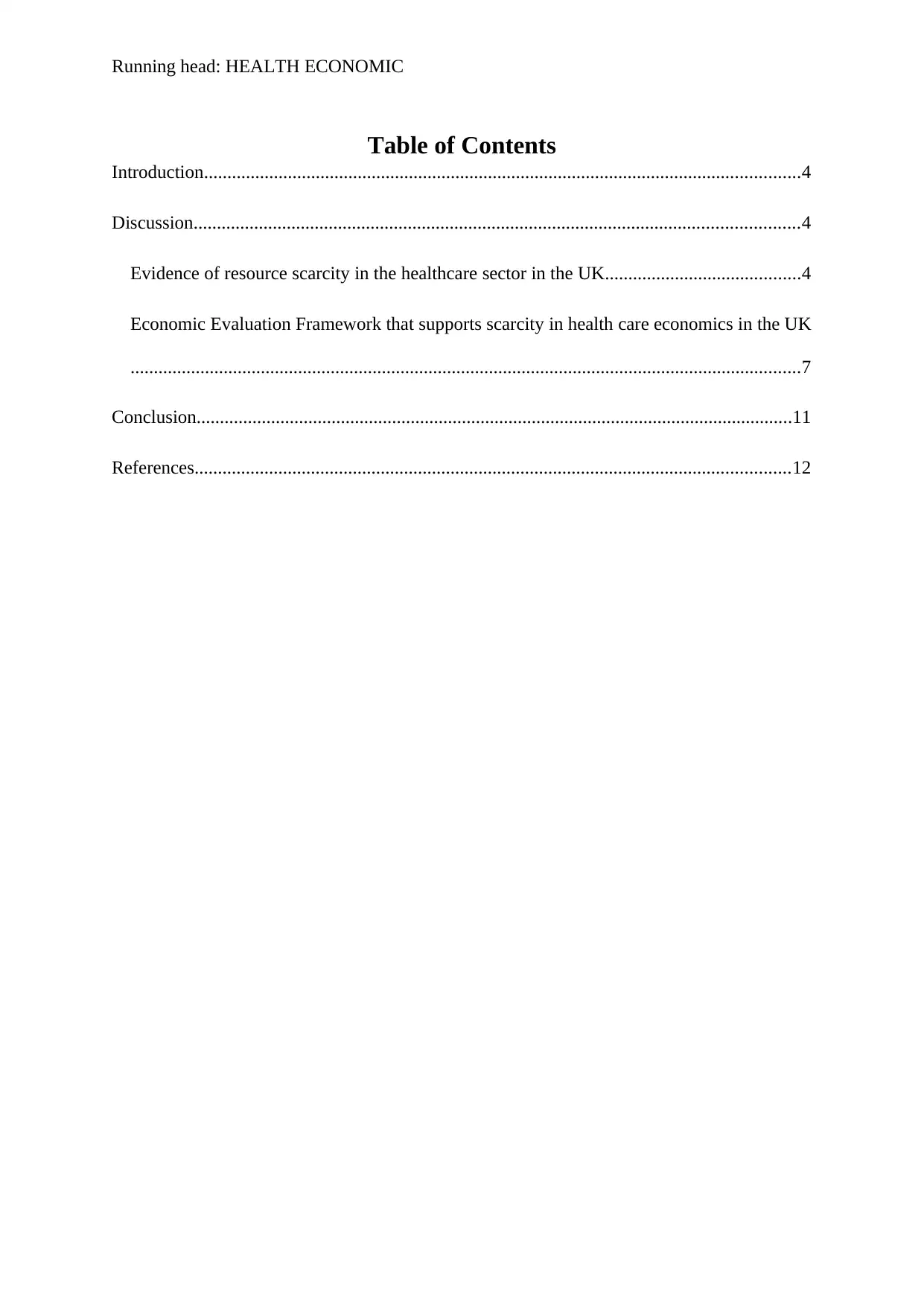
Running head: HEALTH ECONOMIC
Table of Contents
Introduction................................................................................................................................4
Discussion..................................................................................................................................4
Evidence of resource scarcity in the healthcare sector in the UK..........................................4
Economic Evaluation Framework that supports scarcity in health care economics in the UK
................................................................................................................................................7
Conclusion................................................................................................................................11
References................................................................................................................................12
Table of Contents
Introduction................................................................................................................................4
Discussion..................................................................................................................................4
Evidence of resource scarcity in the healthcare sector in the UK..........................................4
Economic Evaluation Framework that supports scarcity in health care economics in the UK
................................................................................................................................................7
Conclusion................................................................................................................................11
References................................................................................................................................12
⊘ This is a preview!⊘
Do you want full access?
Subscribe today to unlock all pages.

Trusted by 1+ million students worldwide
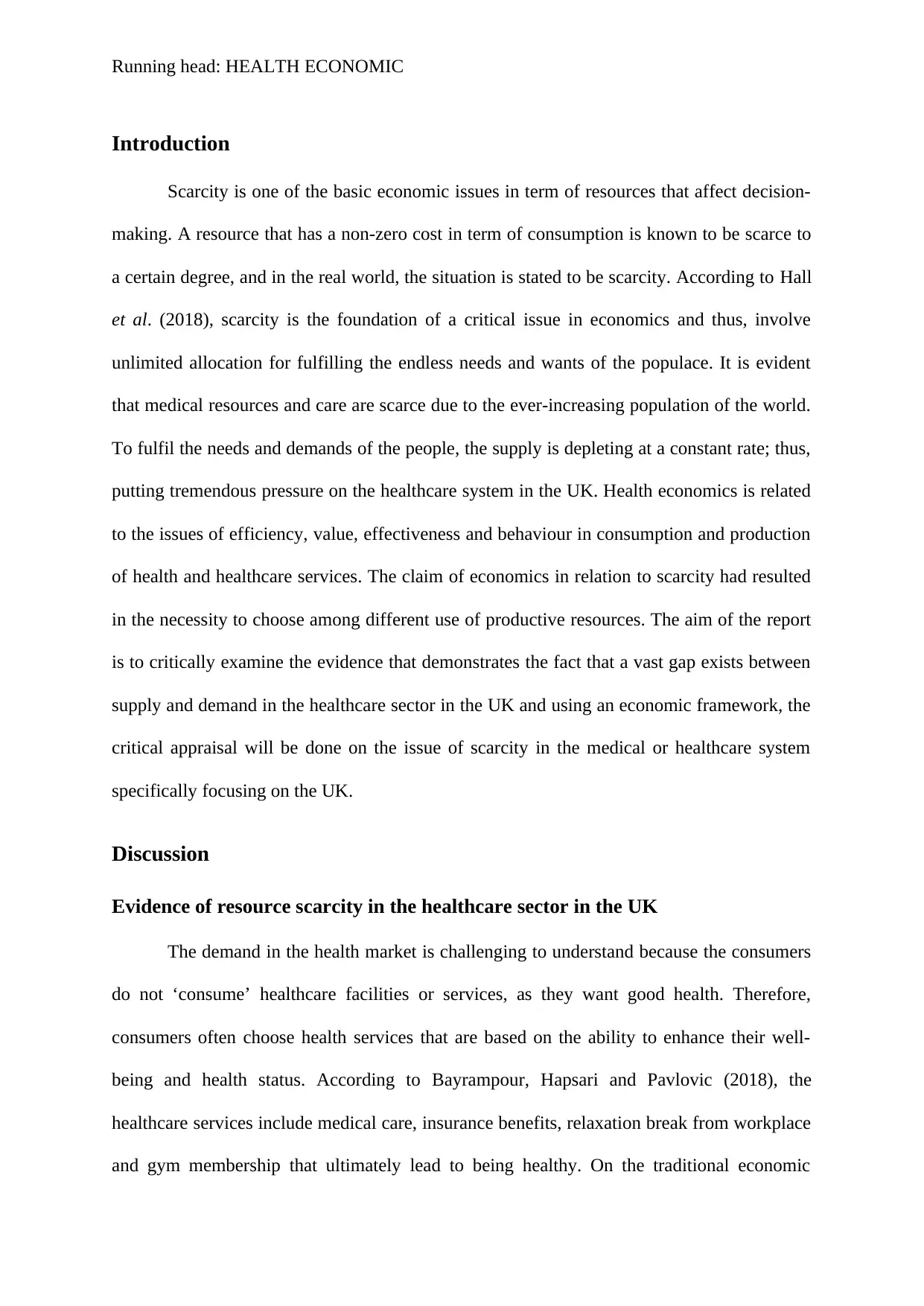
Running head: HEALTH ECONOMIC
Introduction
Scarcity is one of the basic economic issues in term of resources that affect decision-
making. A resource that has a non-zero cost in term of consumption is known to be scarce to
a certain degree, and in the real world, the situation is stated to be scarcity. According to Hall
et al. (2018), scarcity is the foundation of a critical issue in economics and thus, involve
unlimited allocation for fulfilling the endless needs and wants of the populace. It is evident
that medical resources and care are scarce due to the ever-increasing population of the world.
To fulfil the needs and demands of the people, the supply is depleting at a constant rate; thus,
putting tremendous pressure on the healthcare system in the UK. Health economics is related
to the issues of efficiency, value, effectiveness and behaviour in consumption and production
of health and healthcare services. The claim of economics in relation to scarcity had resulted
in the necessity to choose among different use of productive resources. The aim of the report
is to critically examine the evidence that demonstrates the fact that a vast gap exists between
supply and demand in the healthcare sector in the UK and using an economic framework, the
critical appraisal will be done on the issue of scarcity in the medical or healthcare system
specifically focusing on the UK.
Discussion
Evidence of resource scarcity in the healthcare sector in the UK
The demand in the health market is challenging to understand because the consumers
do not ‘consume’ healthcare facilities or services, as they want good health. Therefore,
consumers often choose health services that are based on the ability to enhance their well-
being and health status. According to Bayrampour, Hapsari and Pavlovic (2018), the
healthcare services include medical care, insurance benefits, relaxation break from workplace
and gym membership that ultimately lead to being healthy. On the traditional economic
Introduction
Scarcity is one of the basic economic issues in term of resources that affect decision-
making. A resource that has a non-zero cost in term of consumption is known to be scarce to
a certain degree, and in the real world, the situation is stated to be scarcity. According to Hall
et al. (2018), scarcity is the foundation of a critical issue in economics and thus, involve
unlimited allocation for fulfilling the endless needs and wants of the populace. It is evident
that medical resources and care are scarce due to the ever-increasing population of the world.
To fulfil the needs and demands of the people, the supply is depleting at a constant rate; thus,
putting tremendous pressure on the healthcare system in the UK. Health economics is related
to the issues of efficiency, value, effectiveness and behaviour in consumption and production
of health and healthcare services. The claim of economics in relation to scarcity had resulted
in the necessity to choose among different use of productive resources. The aim of the report
is to critically examine the evidence that demonstrates the fact that a vast gap exists between
supply and demand in the healthcare sector in the UK and using an economic framework, the
critical appraisal will be done on the issue of scarcity in the medical or healthcare system
specifically focusing on the UK.
Discussion
Evidence of resource scarcity in the healthcare sector in the UK
The demand in the health market is challenging to understand because the consumers
do not ‘consume’ healthcare facilities or services, as they want good health. Therefore,
consumers often choose health services that are based on the ability to enhance their well-
being and health status. According to Bayrampour, Hapsari and Pavlovic (2018), the
healthcare services include medical care, insurance benefits, relaxation break from workplace
and gym membership that ultimately lead to being healthy. On the traditional economic
Paraphrase This Document
Need a fresh take? Get an instant paraphrase of this document with our AI Paraphraser
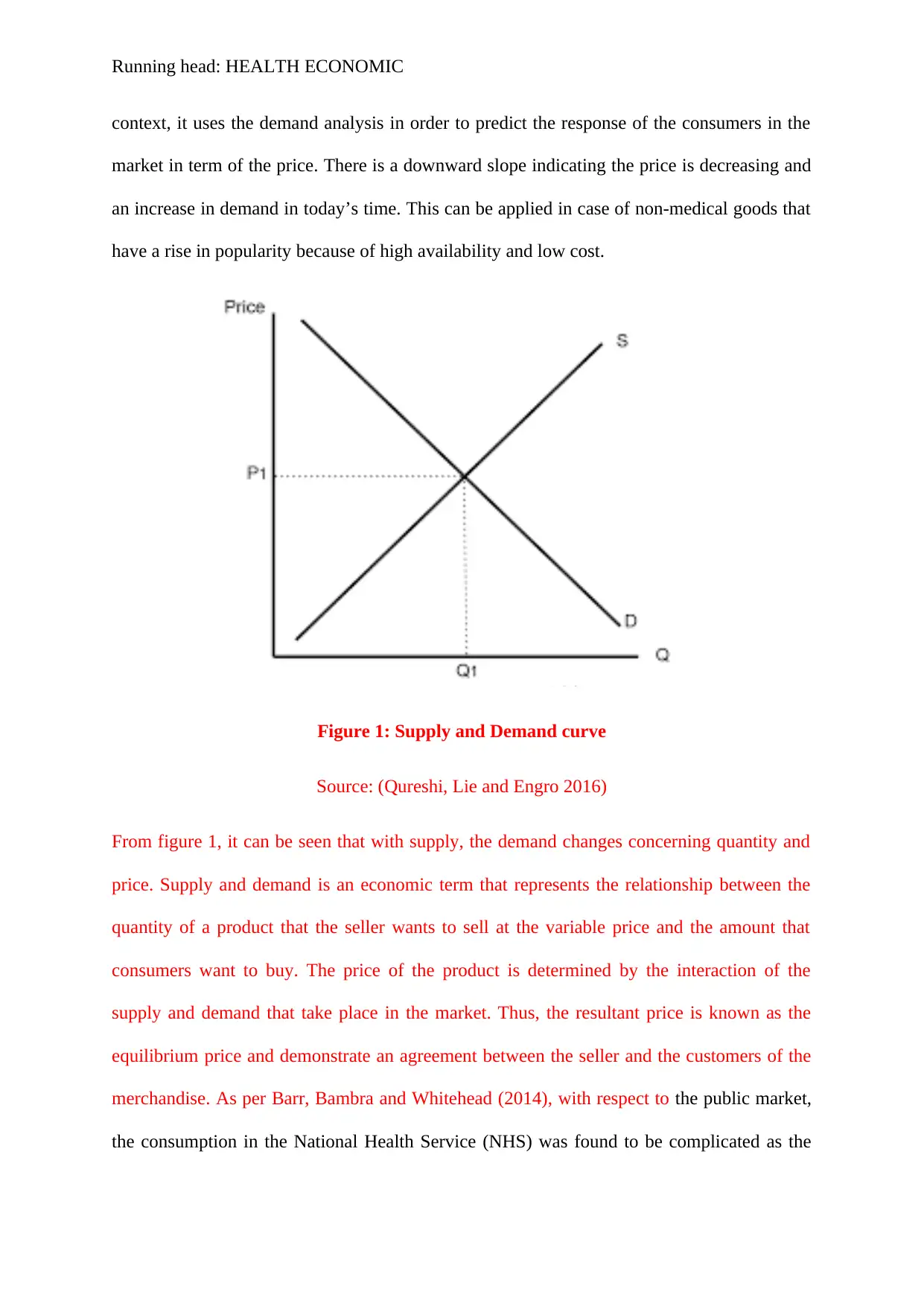
Running head: HEALTH ECONOMIC
context, it uses the demand analysis in order to predict the response of the consumers in the
market in term of the price. There is a downward slope indicating the price is decreasing and
an increase in demand in today’s time. This can be applied in case of non-medical goods that
have a rise in popularity because of high availability and low cost.
Figure 1: Supply and Demand curve
Source: (Qureshi, Lie and Engro 2016)
From figure 1, it can be seen that with supply, the demand changes concerning quantity and
price. Supply and demand is an economic term that represents the relationship between the
quantity of a product that the seller wants to sell at the variable price and the amount that
consumers want to buy. The price of the product is determined by the interaction of the
supply and demand that take place in the market. Thus, the resultant price is known as the
equilibrium price and demonstrate an agreement between the seller and the customers of the
merchandise. As per Barr, Bambra and Whitehead (2014), with respect to the public market,
the consumption in the National Health Service (NHS) was found to be complicated as the
context, it uses the demand analysis in order to predict the response of the consumers in the
market in term of the price. There is a downward slope indicating the price is decreasing and
an increase in demand in today’s time. This can be applied in case of non-medical goods that
have a rise in popularity because of high availability and low cost.
Figure 1: Supply and Demand curve
Source: (Qureshi, Lie and Engro 2016)
From figure 1, it can be seen that with supply, the demand changes concerning quantity and
price. Supply and demand is an economic term that represents the relationship between the
quantity of a product that the seller wants to sell at the variable price and the amount that
consumers want to buy. The price of the product is determined by the interaction of the
supply and demand that take place in the market. Thus, the resultant price is known as the
equilibrium price and demonstrate an agreement between the seller and the customers of the
merchandise. As per Barr, Bambra and Whitehead (2014), with respect to the public market,
the consumption in the National Health Service (NHS) was found to be complicated as the
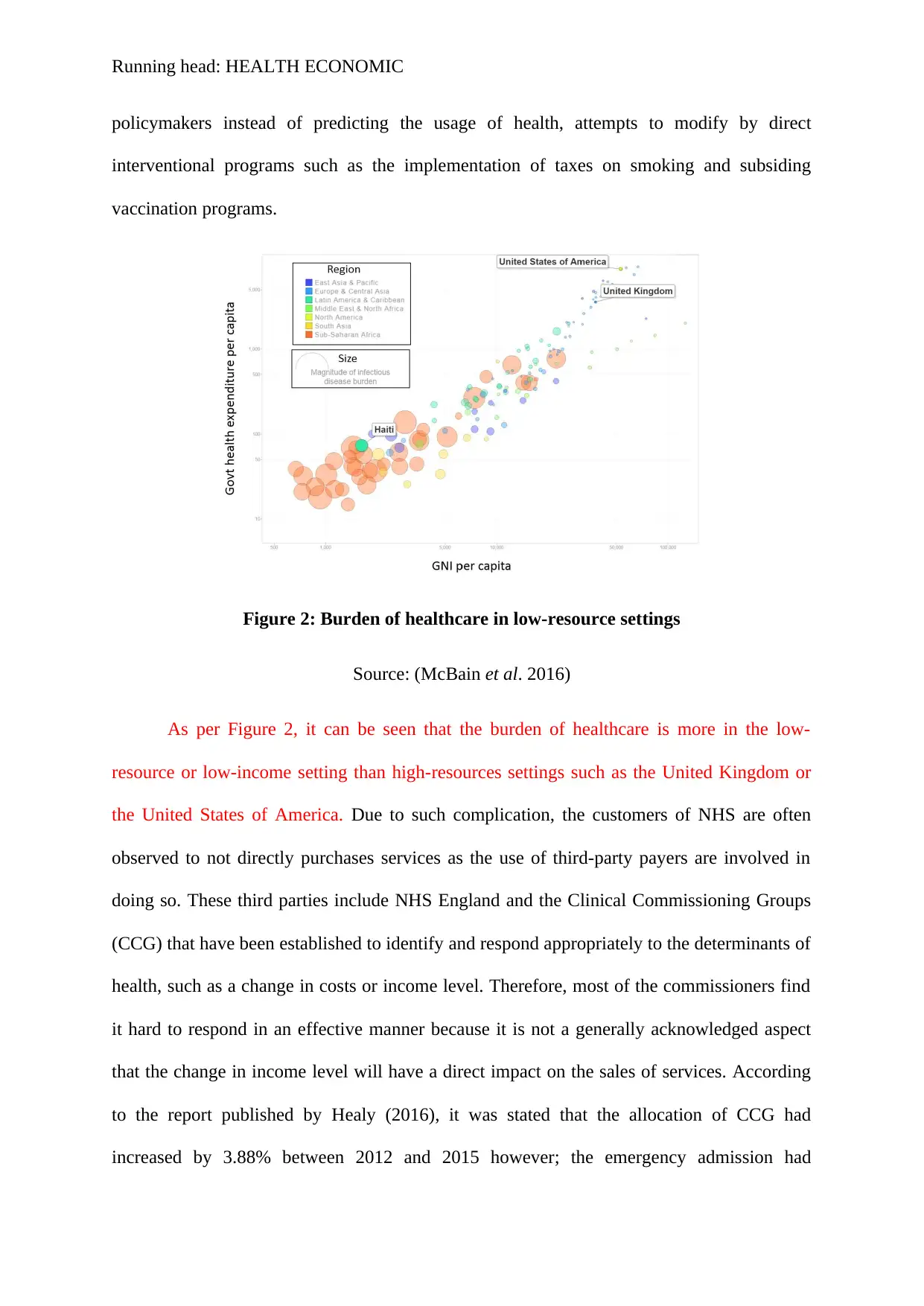
Running head: HEALTH ECONOMIC
policymakers instead of predicting the usage of health, attempts to modify by direct
interventional programs such as the implementation of taxes on smoking and subsiding
vaccination programs.
Figure 2: Burden of healthcare in low-resource settings
Source: (McBain et al. 2016)
As per Figure 2, it can be seen that the burden of healthcare is more in the low-
resource or low-income setting than high-resources settings such as the United Kingdom or
the United States of America. Due to such complication, the customers of NHS are often
observed to not directly purchases services as the use of third-party payers are involved in
doing so. These third parties include NHS England and the Clinical Commissioning Groups
(CCG) that have been established to identify and respond appropriately to the determinants of
health, such as a change in costs or income level. Therefore, most of the commissioners find
it hard to respond in an effective manner because it is not a generally acknowledged aspect
that the change in income level will have a direct impact on the sales of services. According
to the report published by Healy (2016), it was stated that the allocation of CCG had
increased by 3.88% between 2012 and 2015 however; the emergency admission had
policymakers instead of predicting the usage of health, attempts to modify by direct
interventional programs such as the implementation of taxes on smoking and subsiding
vaccination programs.
Figure 2: Burden of healthcare in low-resource settings
Source: (McBain et al. 2016)
As per Figure 2, it can be seen that the burden of healthcare is more in the low-
resource or low-income setting than high-resources settings such as the United Kingdom or
the United States of America. Due to such complication, the customers of NHS are often
observed to not directly purchases services as the use of third-party payers are involved in
doing so. These third parties include NHS England and the Clinical Commissioning Groups
(CCG) that have been established to identify and respond appropriately to the determinants of
health, such as a change in costs or income level. Therefore, most of the commissioners find
it hard to respond in an effective manner because it is not a generally acknowledged aspect
that the change in income level will have a direct impact on the sales of services. According
to the report published by Healy (2016), it was stated that the allocation of CCG had
increased by 3.88% between 2012 and 2015 however; the emergency admission had
⊘ This is a preview!⊘
Do you want full access?
Subscribe today to unlock all pages.

Trusted by 1+ million students worldwide
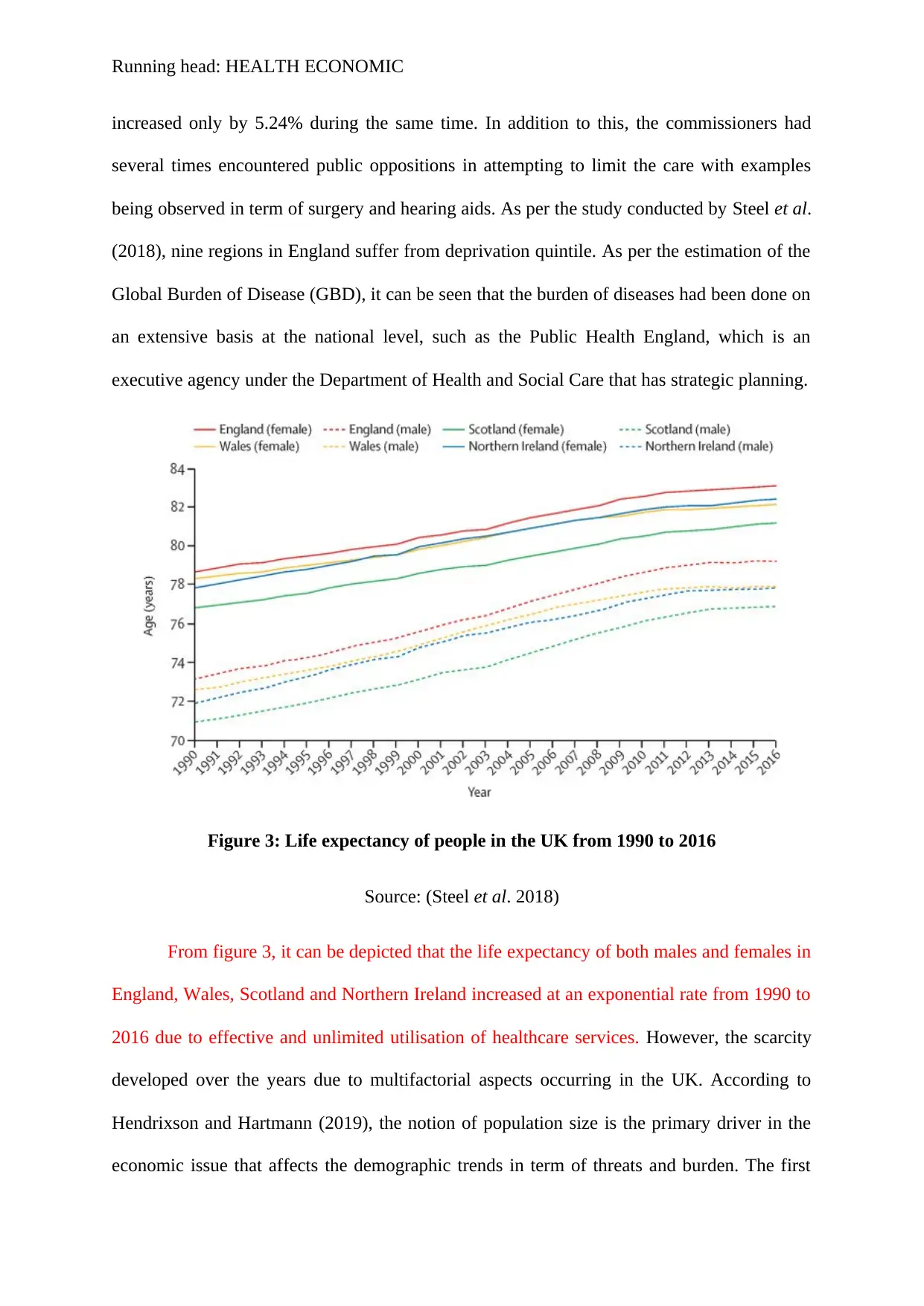
Running head: HEALTH ECONOMIC
increased only by 5.24% during the same time. In addition to this, the commissioners had
several times encountered public oppositions in attempting to limit the care with examples
being observed in term of surgery and hearing aids. As per the study conducted by Steel et al.
(2018), nine regions in England suffer from deprivation quintile. As per the estimation of the
Global Burden of Disease (GBD), it can be seen that the burden of diseases had been done on
an extensive basis at the national level, such as the Public Health England, which is an
executive agency under the Department of Health and Social Care that has strategic planning.
Figure 3: Life expectancy of people in the UK from 1990 to 2016
Source: (Steel et al. 2018)
From figure 3, it can be depicted that the life expectancy of both males and females in
England, Wales, Scotland and Northern Ireland increased at an exponential rate from 1990 to
2016 due to effective and unlimited utilisation of healthcare services. However, the scarcity
developed over the years due to multifactorial aspects occurring in the UK. According to
Hendrixson and Hartmann (2019), the notion of population size is the primary driver in the
economic issue that affects the demographic trends in term of threats and burden. The first
increased only by 5.24% during the same time. In addition to this, the commissioners had
several times encountered public oppositions in attempting to limit the care with examples
being observed in term of surgery and hearing aids. As per the study conducted by Steel et al.
(2018), nine regions in England suffer from deprivation quintile. As per the estimation of the
Global Burden of Disease (GBD), it can be seen that the burden of diseases had been done on
an extensive basis at the national level, such as the Public Health England, which is an
executive agency under the Department of Health and Social Care that has strategic planning.
Figure 3: Life expectancy of people in the UK from 1990 to 2016
Source: (Steel et al. 2018)
From figure 3, it can be depicted that the life expectancy of both males and females in
England, Wales, Scotland and Northern Ireland increased at an exponential rate from 1990 to
2016 due to effective and unlimited utilisation of healthcare services. However, the scarcity
developed over the years due to multifactorial aspects occurring in the UK. According to
Hendrixson and Hartmann (2019), the notion of population size is the primary driver in the
economic issue that affects the demographic trends in term of threats and burden. The first
Paraphrase This Document
Need a fresh take? Get an instant paraphrase of this document with our AI Paraphraser
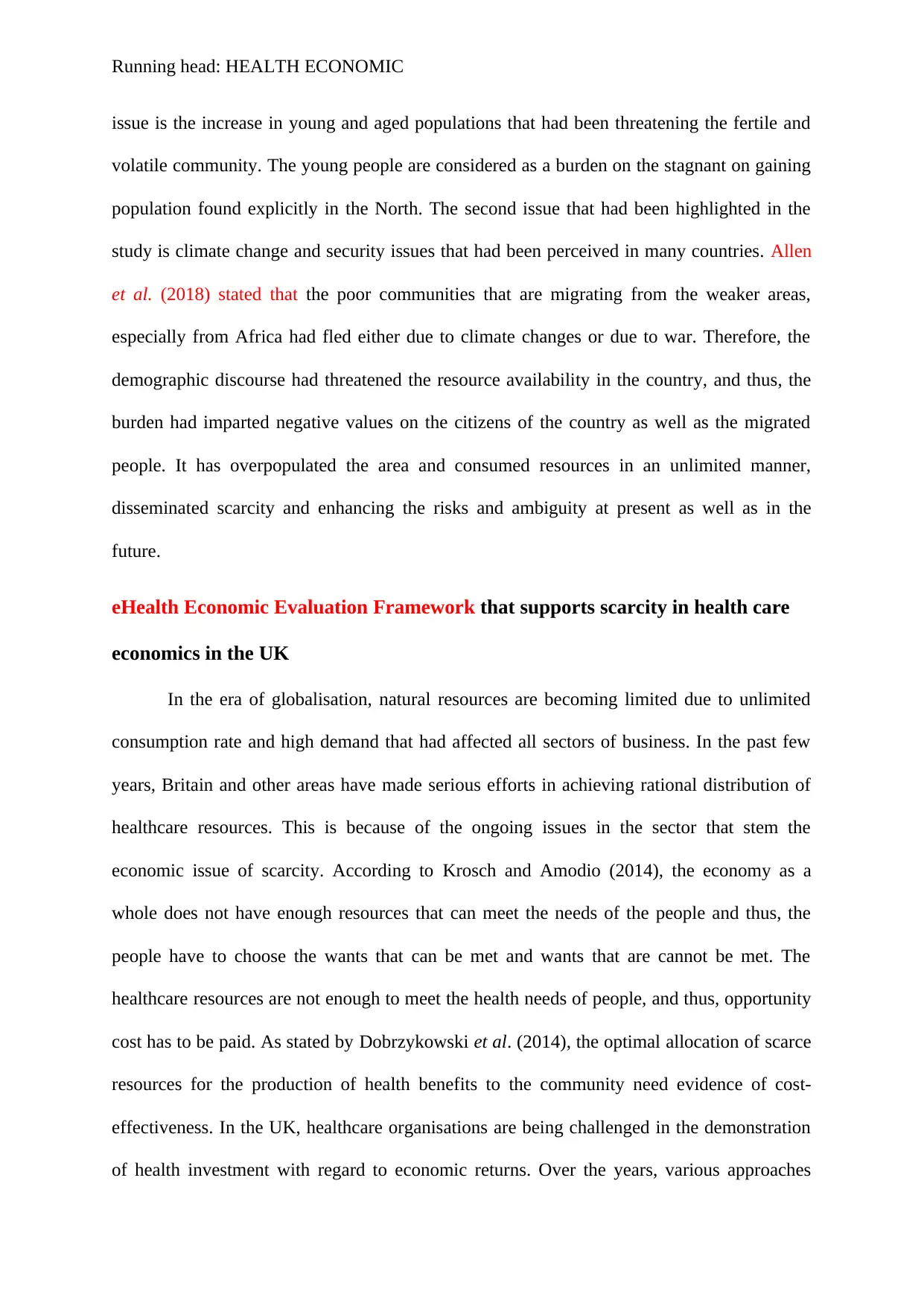
Running head: HEALTH ECONOMIC
issue is the increase in young and aged populations that had been threatening the fertile and
volatile community. The young people are considered as a burden on the stagnant on gaining
population found explicitly in the North. The second issue that had been highlighted in the
study is climate change and security issues that had been perceived in many countries. Allen
et al. (2018) stated that the poor communities that are migrating from the weaker areas,
especially from Africa had fled either due to climate changes or due to war. Therefore, the
demographic discourse had threatened the resource availability in the country, and thus, the
burden had imparted negative values on the citizens of the country as well as the migrated
people. It has overpopulated the area and consumed resources in an unlimited manner,
disseminated scarcity and enhancing the risks and ambiguity at present as well as in the
future.
eHealth Economic Evaluation Framework that supports scarcity in health care
economics in the UK
In the era of globalisation, natural resources are becoming limited due to unlimited
consumption rate and high demand that had affected all sectors of business. In the past few
years, Britain and other areas have made serious efforts in achieving rational distribution of
healthcare resources. This is because of the ongoing issues in the sector that stem the
economic issue of scarcity. According to Krosch and Amodio (2014), the economy as a
whole does not have enough resources that can meet the needs of the people and thus, the
people have to choose the wants that can be met and wants that are cannot be met. The
healthcare resources are not enough to meet the health needs of people, and thus, opportunity
cost has to be paid. As stated by Dobrzykowski et al. (2014), the optimal allocation of scarce
resources for the production of health benefits to the community need evidence of cost-
effectiveness. In the UK, healthcare organisations are being challenged in the demonstration
of health investment with regard to economic returns. Over the years, various approaches
issue is the increase in young and aged populations that had been threatening the fertile and
volatile community. The young people are considered as a burden on the stagnant on gaining
population found explicitly in the North. The second issue that had been highlighted in the
study is climate change and security issues that had been perceived in many countries. Allen
et al. (2018) stated that the poor communities that are migrating from the weaker areas,
especially from Africa had fled either due to climate changes or due to war. Therefore, the
demographic discourse had threatened the resource availability in the country, and thus, the
burden had imparted negative values on the citizens of the country as well as the migrated
people. It has overpopulated the area and consumed resources in an unlimited manner,
disseminated scarcity and enhancing the risks and ambiguity at present as well as in the
future.
eHealth Economic Evaluation Framework that supports scarcity in health care
economics in the UK
In the era of globalisation, natural resources are becoming limited due to unlimited
consumption rate and high demand that had affected all sectors of business. In the past few
years, Britain and other areas have made serious efforts in achieving rational distribution of
healthcare resources. This is because of the ongoing issues in the sector that stem the
economic issue of scarcity. According to Krosch and Amodio (2014), the economy as a
whole does not have enough resources that can meet the needs of the people and thus, the
people have to choose the wants that can be met and wants that are cannot be met. The
healthcare resources are not enough to meet the health needs of people, and thus, opportunity
cost has to be paid. As stated by Dobrzykowski et al. (2014), the optimal allocation of scarce
resources for the production of health benefits to the community need evidence of cost-
effectiveness. In the UK, healthcare organisations are being challenged in the demonstration
of health investment with regard to economic returns. Over the years, various approaches
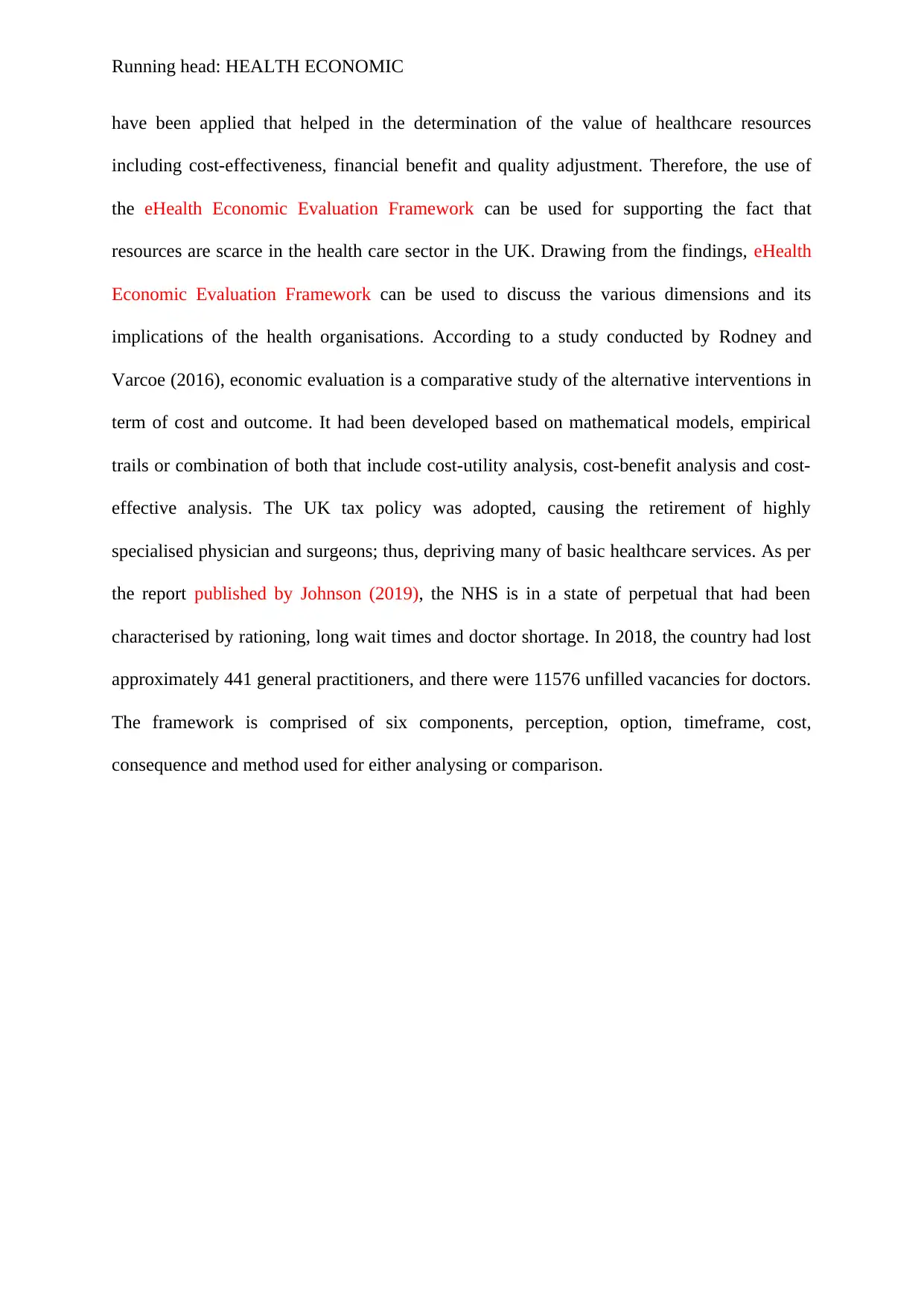
Running head: HEALTH ECONOMIC
have been applied that helped in the determination of the value of healthcare resources
including cost-effectiveness, financial benefit and quality adjustment. Therefore, the use of
the eHealth Economic Evaluation Framework can be used for supporting the fact that
resources are scarce in the health care sector in the UK. Drawing from the findings, eHealth
Economic Evaluation Framework can be used to discuss the various dimensions and its
implications of the health organisations. According to a study conducted by Rodney and
Varcoe (2016), economic evaluation is a comparative study of the alternative interventions in
term of cost and outcome. It had been developed based on mathematical models, empirical
trails or combination of both that include cost-utility analysis, cost-benefit analysis and cost-
effective analysis. The UK tax policy was adopted, causing the retirement of highly
specialised physician and surgeons; thus, depriving many of basic healthcare services. As per
the report published by Johnson (2019), the NHS is in a state of perpetual that had been
characterised by rationing, long wait times and doctor shortage. In 2018, the country had lost
approximately 441 general practitioners, and there were 11576 unfilled vacancies for doctors.
The framework is comprised of six components, perception, option, timeframe, cost,
consequence and method used for either analysing or comparison.
have been applied that helped in the determination of the value of healthcare resources
including cost-effectiveness, financial benefit and quality adjustment. Therefore, the use of
the eHealth Economic Evaluation Framework can be used for supporting the fact that
resources are scarce in the health care sector in the UK. Drawing from the findings, eHealth
Economic Evaluation Framework can be used to discuss the various dimensions and its
implications of the health organisations. According to a study conducted by Rodney and
Varcoe (2016), economic evaluation is a comparative study of the alternative interventions in
term of cost and outcome. It had been developed based on mathematical models, empirical
trails or combination of both that include cost-utility analysis, cost-benefit analysis and cost-
effective analysis. The UK tax policy was adopted, causing the retirement of highly
specialised physician and surgeons; thus, depriving many of basic healthcare services. As per
the report published by Johnson (2019), the NHS is in a state of perpetual that had been
characterised by rationing, long wait times and doctor shortage. In 2018, the country had lost
approximately 441 general practitioners, and there were 11576 unfilled vacancies for doctors.
The framework is comprised of six components, perception, option, timeframe, cost,
consequence and method used for either analysing or comparison.
⊘ This is a preview!⊘
Do you want full access?
Subscribe today to unlock all pages.

Trusted by 1+ million students worldwide
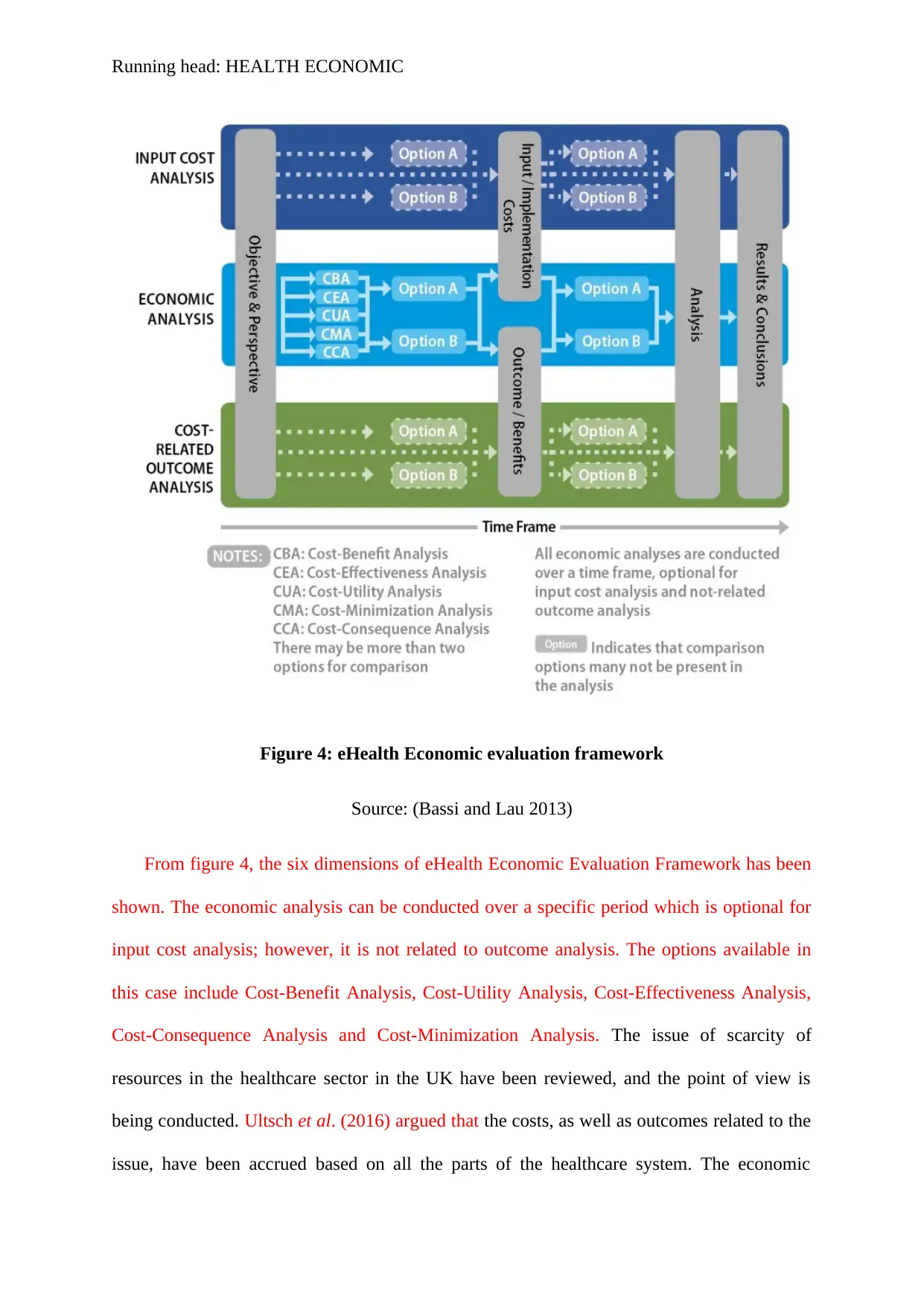
Running head: HEALTH ECONOMIC
Figure 4: eHealth Economic evaluation framework
Source: (Bassi and Lau 2013)
From figure 4, the six dimensions of eHealth Economic Evaluation Framework has been
shown. The economic analysis can be conducted over a specific period which is optional for
input cost analysis; however, it is not related to outcome analysis. The options available in
this case include Cost-Benefit Analysis, Cost-Utility Analysis, Cost-Effectiveness Analysis,
Cost-Consequence Analysis and Cost-Minimization Analysis. The issue of scarcity of
resources in the healthcare sector in the UK have been reviewed, and the point of view is
being conducted. Ultsch et al. (2016) argued that the costs, as well as outcomes related to the
issue, have been accrued based on all the parts of the healthcare system. The economic
Figure 4: eHealth Economic evaluation framework
Source: (Bassi and Lau 2013)
From figure 4, the six dimensions of eHealth Economic Evaluation Framework has been
shown. The economic analysis can be conducted over a specific period which is optional for
input cost analysis; however, it is not related to outcome analysis. The options available in
this case include Cost-Benefit Analysis, Cost-Utility Analysis, Cost-Effectiveness Analysis,
Cost-Consequence Analysis and Cost-Minimization Analysis. The issue of scarcity of
resources in the healthcare sector in the UK have been reviewed, and the point of view is
being conducted. Ultsch et al. (2016) argued that the costs, as well as outcomes related to the
issue, have been accrued based on all the parts of the healthcare system. The economic
Paraphrase This Document
Need a fresh take? Get an instant paraphrase of this document with our AI Paraphraser
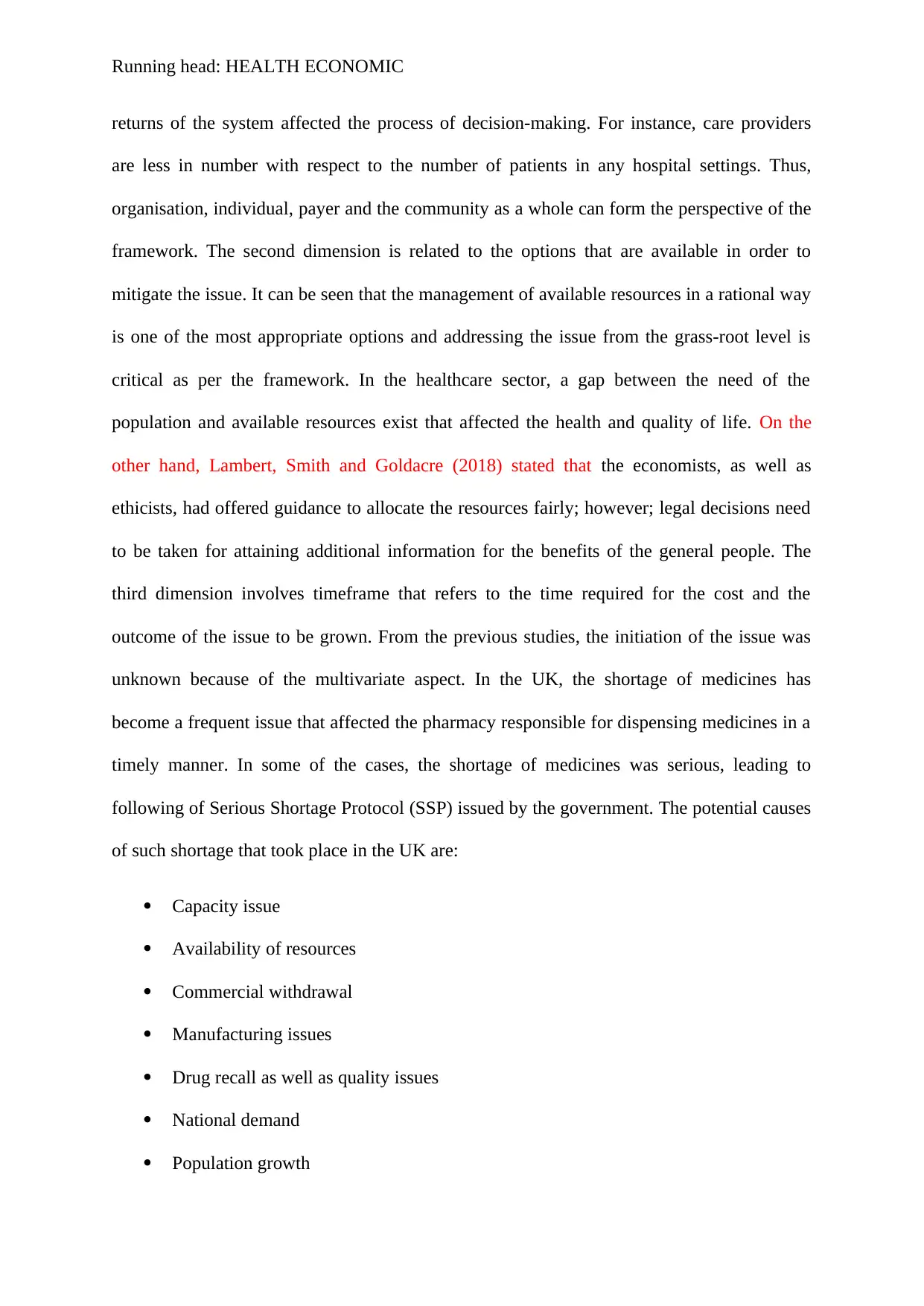
Running head: HEALTH ECONOMIC
returns of the system affected the process of decision-making. For instance, care providers
are less in number with respect to the number of patients in any hospital settings. Thus,
organisation, individual, payer and the community as a whole can form the perspective of the
framework. The second dimension is related to the options that are available in order to
mitigate the issue. It can be seen that the management of available resources in a rational way
is one of the most appropriate options and addressing the issue from the grass-root level is
critical as per the framework. In the healthcare sector, a gap between the need of the
population and available resources exist that affected the health and quality of life. On the
other hand, Lambert, Smith and Goldacre (2018) stated that the economists, as well as
ethicists, had offered guidance to allocate the resources fairly; however; legal decisions need
to be taken for attaining additional information for the benefits of the general people. The
third dimension involves timeframe that refers to the time required for the cost and the
outcome of the issue to be grown. From the previous studies, the initiation of the issue was
unknown because of the multivariate aspect. In the UK, the shortage of medicines has
become a frequent issue that affected the pharmacy responsible for dispensing medicines in a
timely manner. In some of the cases, the shortage of medicines was serious, leading to
following of Serious Shortage Protocol (SSP) issued by the government. The potential causes
of such shortage that took place in the UK are:
Capacity issue
Availability of resources
Commercial withdrawal
Manufacturing issues
Drug recall as well as quality issues
National demand
Population growth
returns of the system affected the process of decision-making. For instance, care providers
are less in number with respect to the number of patients in any hospital settings. Thus,
organisation, individual, payer and the community as a whole can form the perspective of the
framework. The second dimension is related to the options that are available in order to
mitigate the issue. It can be seen that the management of available resources in a rational way
is one of the most appropriate options and addressing the issue from the grass-root level is
critical as per the framework. In the healthcare sector, a gap between the need of the
population and available resources exist that affected the health and quality of life. On the
other hand, Lambert, Smith and Goldacre (2018) stated that the economists, as well as
ethicists, had offered guidance to allocate the resources fairly; however; legal decisions need
to be taken for attaining additional information for the benefits of the general people. The
third dimension involves timeframe that refers to the time required for the cost and the
outcome of the issue to be grown. From the previous studies, the initiation of the issue was
unknown because of the multivariate aspect. In the UK, the shortage of medicines has
become a frequent issue that affected the pharmacy responsible for dispensing medicines in a
timely manner. In some of the cases, the shortage of medicines was serious, leading to
following of Serious Shortage Protocol (SSP) issued by the government. The potential causes
of such shortage that took place in the UK are:
Capacity issue
Availability of resources
Commercial withdrawal
Manufacturing issues
Drug recall as well as quality issues
National demand
Population growth
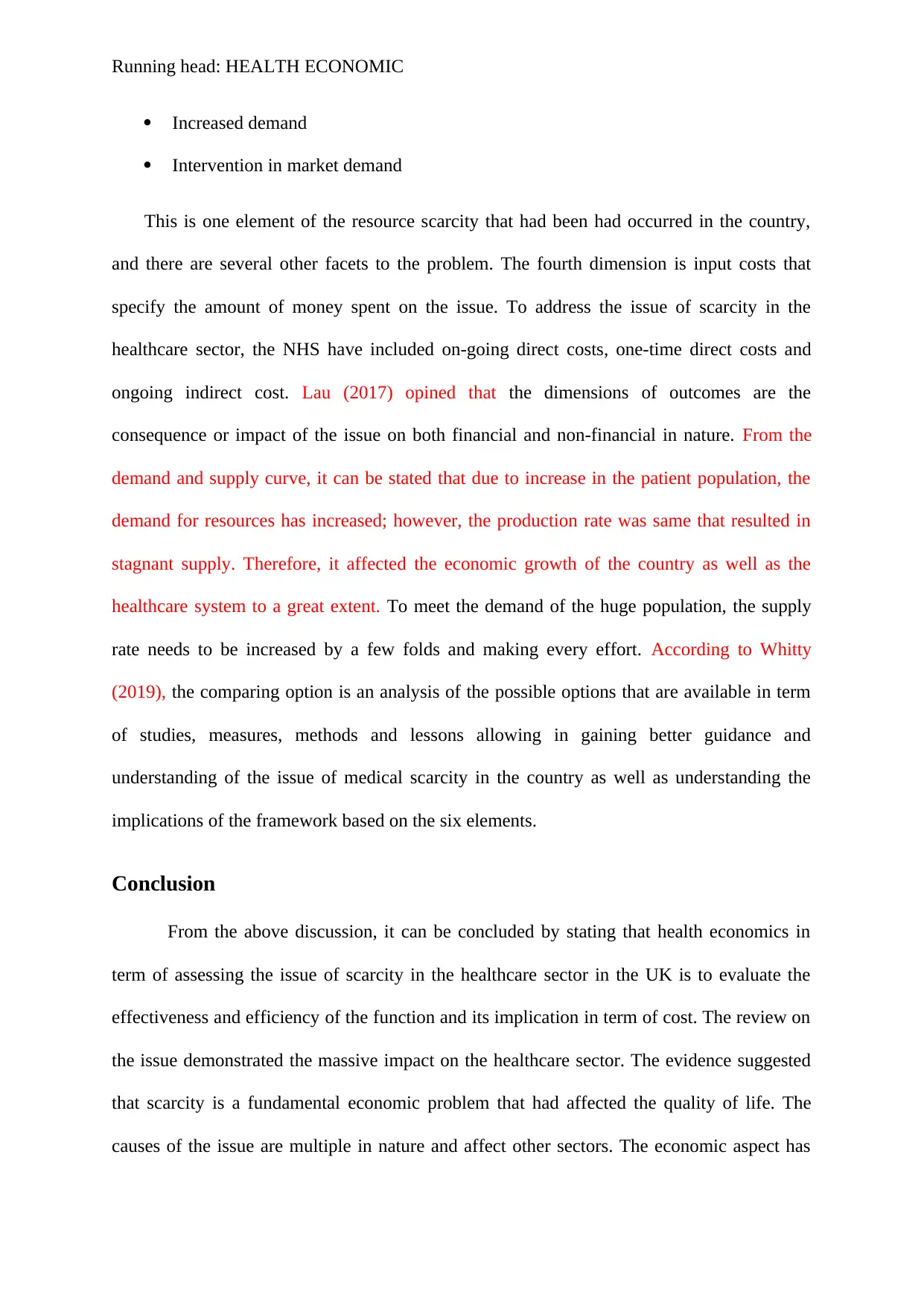
Running head: HEALTH ECONOMIC
Increased demand
Intervention in market demand
This is one element of the resource scarcity that had been had occurred in the country,
and there are several other facets to the problem. The fourth dimension is input costs that
specify the amount of money spent on the issue. To address the issue of scarcity in the
healthcare sector, the NHS have included on-going direct costs, one-time direct costs and
ongoing indirect cost. Lau (2017) opined that the dimensions of outcomes are the
consequence or impact of the issue on both financial and non-financial in nature. From the
demand and supply curve, it can be stated that due to increase in the patient population, the
demand for resources has increased; however, the production rate was same that resulted in
stagnant supply. Therefore, it affected the economic growth of the country as well as the
healthcare system to a great extent. To meet the demand of the huge population, the supply
rate needs to be increased by a few folds and making every effort. According to Whitty
(2019), the comparing option is an analysis of the possible options that are available in term
of studies, measures, methods and lessons allowing in gaining better guidance and
understanding of the issue of medical scarcity in the country as well as understanding the
implications of the framework based on the six elements.
Conclusion
From the above discussion, it can be concluded by stating that health economics in
term of assessing the issue of scarcity in the healthcare sector in the UK is to evaluate the
effectiveness and efficiency of the function and its implication in term of cost. The review on
the issue demonstrated the massive impact on the healthcare sector. The evidence suggested
that scarcity is a fundamental economic problem that had affected the quality of life. The
causes of the issue are multiple in nature and affect other sectors. The economic aspect has
Increased demand
Intervention in market demand
This is one element of the resource scarcity that had been had occurred in the country,
and there are several other facets to the problem. The fourth dimension is input costs that
specify the amount of money spent on the issue. To address the issue of scarcity in the
healthcare sector, the NHS have included on-going direct costs, one-time direct costs and
ongoing indirect cost. Lau (2017) opined that the dimensions of outcomes are the
consequence or impact of the issue on both financial and non-financial in nature. From the
demand and supply curve, it can be stated that due to increase in the patient population, the
demand for resources has increased; however, the production rate was same that resulted in
stagnant supply. Therefore, it affected the economic growth of the country as well as the
healthcare system to a great extent. To meet the demand of the huge population, the supply
rate needs to be increased by a few folds and making every effort. According to Whitty
(2019), the comparing option is an analysis of the possible options that are available in term
of studies, measures, methods and lessons allowing in gaining better guidance and
understanding of the issue of medical scarcity in the country as well as understanding the
implications of the framework based on the six elements.
Conclusion
From the above discussion, it can be concluded by stating that health economics in
term of assessing the issue of scarcity in the healthcare sector in the UK is to evaluate the
effectiveness and efficiency of the function and its implication in term of cost. The review on
the issue demonstrated the massive impact on the healthcare sector. The evidence suggested
that scarcity is a fundamental economic problem that had affected the quality of life. The
causes of the issue are multiple in nature and affect other sectors. The economic aspect has
⊘ This is a preview!⊘
Do you want full access?
Subscribe today to unlock all pages.

Trusted by 1+ million students worldwide
1 out of 16
Related Documents
Your All-in-One AI-Powered Toolkit for Academic Success.
+13062052269
info@desklib.com
Available 24*7 on WhatsApp / Email
![[object Object]](/_next/static/media/star-bottom.7253800d.svg)
Unlock your academic potential
Copyright © 2020–2025 A2Z Services. All Rights Reserved. Developed and managed by ZUCOL.





